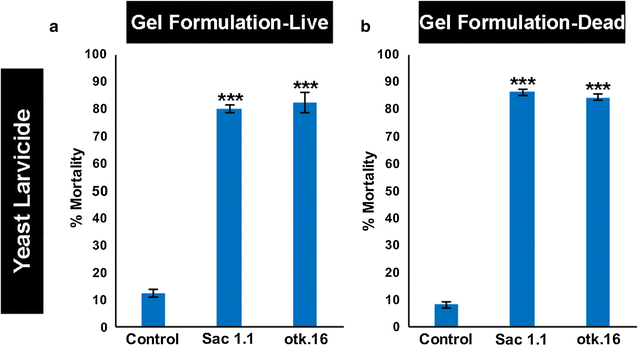Yeast interfering RNA larvicides targeting neural genes induce high rates of Anopheles larval mortality
- PMID: 29132374
- PMCID: PMC5683233
- DOI: 10.1186/s12936-017-2112-5
Yeast interfering RNA larvicides targeting neural genes induce high rates of Anopheles larval mortality
Abstract
Background: Although larviciding can reduce the number of outdoor biting malaria vector mosquitoes, which may help to prevent residual malaria transmission, the current larvicide repertoire is faced with great challenges to sustainability. The identification of new effective, economical, and biorational larvicides could facilitate maintenance and expansion of the practice of larviciding in integrated malaria vector mosquito control programmes. Interfering RNA molecules represent a novel class of larvicides with untapped potential for sustainable mosquito control. This investigation tested the hypothesis that short interfering RNA molecules can be used as mosquito larvicides.
Results: A small interfering RNA (siRNA) screen for larval lethal genes identified siRNAs corresponding to the Anopheles gambiae suppressor of actin (Sac1), leukocyte receptor complex member (lrc), and offtrack (otk) genes. Saccharomyces cerevisiae (baker's yeast) was engineered to produce short hairpin RNAs (shRNAs) for silencing of these genes. Feeding larvae with the engineered yeasts resulted in silenced target gene expression, a severe loss of neural synapses in the larval brain, and high levels of larval mortality. The larvicidal activities of yeast interfering RNA larvicides were retained following heat inactivation and drying of the yeast into user-friendly tablet formulations that induced up to 100% larval mortality in laboratory trials.
Conclusions: Ready-to-use dried inactivated yeast interfering RNA larvicide tablets may someday be an effective and inexpensive addition to malaria mosquito control programmes and a valuable, biorational tool for addressing residual malaria transmission.
Keywords: Brain; Larvae; Larviciding; Malaria; Mosquito; Pesticide; RNAi; Saccharomyces cerevisiae; Synapse; Vector.
Figures





Similar articles
-
Lure-and-Kill Yeast Interfering RNA Larvicides Targeting Neural Genes in the Human Disease Vector Mosquito Aedes aegypti.Sci Rep. 2017 Oct 16;7(1):13223. doi: 10.1038/s41598-017-13566-y. Sci Rep. 2017. PMID: 29038510 Free PMC article.
-
Community acceptance of yeast interfering RNA larvicide technology for control of Aedes mosquitoes in Trinidad.PLoS One. 2020 Aug 14;15(8):e0237675. doi: 10.1371/journal.pone.0237675. eCollection 2020. PLoS One. 2020. PMID: 32797066 Free PMC article.
-
Characterization of a broad-based mosquito yeast interfering RNA larvicide with a conserved target site in mosquito semaphorin-1a genes.Parasit Vectors. 2019 May 22;12(1):256. doi: 10.1186/s13071-019-3504-x. Parasit Vectors. 2019. PMID: 31118082 Free PMC article.
-
Bacterial larvicides used for malaria vector control in sub-Saharan Africa: review of their effectiveness and operational feasibility.Parasit Vectors. 2019 Aug 30;12(1):426. doi: 10.1186/s13071-019-3683-5. Parasit Vectors. 2019. PMID: 31470885 Free PMC article. Review.
-
Contributions of Anopheles larval control to malaria suppression in tropical Africa: review of achievements and potential.Med Vet Entomol. 2007 Mar;21(1):2-21. doi: 10.1111/j.1365-2915.2007.00674.x. Med Vet Entomol. 2007. PMID: 17373942 Review.
Cited by
-
RNAi-based bioinsecticide for Aedes mosquito control.Sci Rep. 2019 Mar 11;9(1):4038. doi: 10.1038/s41598-019-39666-5. Sci Rep. 2019. PMID: 30858430 Free PMC article.
-
Characterization of an adulticidal and larvicidal interfering RNA pesticide that targets a conserved sequence in mosquito G protein-coupled dopamine 1 receptor genes.Insect Biochem Mol Biol. 2020 May;120:103359. doi: 10.1016/j.ibmb.2020.103359. Epub 2020 Mar 10. Insect Biochem Mol Biol. 2020. PMID: 32169582 Free PMC article.
-
Mosquito control practices and perceptions: An analysis of economic stakeholders during the Zika epidemic in Belize, Central America.PLoS One. 2018 Jul 19;13(7):e0201075. doi: 10.1371/journal.pone.0201075. eCollection 2018. PLoS One. 2018. PMID: 30024951 Free PMC article.
-
Development of CS-TPP-dsRNA nanoparticles to enhance RNAi efficiency in the yellow fever mosquito, Aedes aegypti.Sci Rep. 2019 Jun 19;9(1):8775. doi: 10.1038/s41598-019-45019-z. Sci Rep. 2019. PMID: 31217512 Free PMC article.
-
Assessment of Trinidad community stakeholder perspectives on the use of yeast interfering RNA-baited ovitraps for biorational control of Aedes mosquitoes.PLoS One. 2021 Jun 29;16(6):e0252997. doi: 10.1371/journal.pone.0252997. eCollection 2021. PLoS One. 2021. PMID: 34185784 Free PMC article.
References
-
- WHO. World malaria report 2016. Geneva: World Health Organization; 2016.
-
- WHO. Larval source management: a supplementary measure for malaria vector control: an operational manual. Geneva: World Health Organization; 2013.
MeSH terms
Substances
Grants and funding
LinkOut - more resources
Full Text Sources
Other Literature Sources
Molecular Biology Databases
Research Materials

